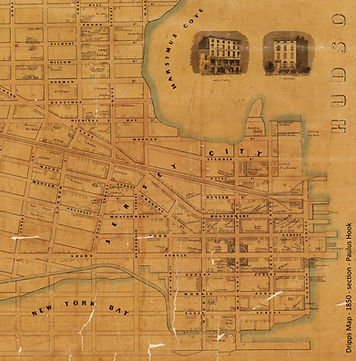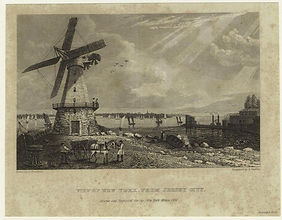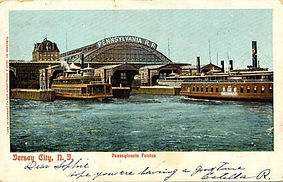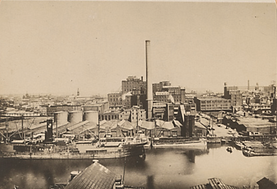HISTORY HAPPENED HERE
Paulus Hook’s rich history dates from its first people, the Lenni Lenape who came for the oyster beds on the shores of its estuaries; there wasn’t much to live on - just a little piece land that jutted out into the Hudson River, an island at high tide. Settled by the Dutch in the early 1700s, who were sent by their “high and mightinesses” to establish the first NJ settlement, Paulus Hook was then fought for, won and lost by the British after 1779. All have left their mark, but those marks aren’t so easy to see anymore. The salt marsh around the little island has been filled, the street grid that was designed and developed by the Associates of the Jersey Company, among them Alexander Hamilton, has seen the little settlement grow - first, Italianate Victorian homes, then factories and railroad tracks carrying people and industry to the waterfront. Some demolished for new offices and residential buildings, some lovingly restored.
History Happened Here uncoverS Paulus Hook’s history, from its churches, reserved as sites on the earliest maps, to its checkered role with slave-ownership, to its becoming a working class neighborhood during the Industrial Revolution, where residents labored in the dirty, rat-infested factories along the waterfront in “Gammontown,” which comes from the Dutch word, “gemeen,” meaning “dirty” or “shabby.”

Our goal is to ultimately create an interactive map of places and what happened at those places – a narrative of events and people across timelines that does not currently exist. Working with our partners, the Jersey City Landmarks Conservancy and the Museum of Jersey City History, and funded by an incubation grant from the New Jersey Council for the Humanities, History Happened Here is an early prototype. We invite you to follow our journey through the centuries and give us input on what you - the community - want to see, hear and engage with.
Think you've seen everything in Paulus Hook? Preservationist, John Gomez and our partner, the Jersey City Landmarks Conservancy challenge you to Go on a history hunt!

1. THE TABERNACLE/ELKS CLUB (DEMOLISHED - NOW OLC SCHOOL)
The Tabernacle was Hudson County's Prudential Center of its time — the biggest space for cultural events and rallies, it opened in 1863 and a few months later was threatened by a raging mob with torches. Its famous pastor John Milton Holmes was hated by racist citizens for his national stand against slavery. Harriet Beecher Stowe, Horace Greeley, Alice A. Holmes all appeared at the Tabernacle, as well as famous 19th century opera singers, composers, dramatists, suffragists, Lincoln admirers, and on and on. It was the hottest spot around because of its unabashed abolitionist followers and Union adherence. The Tabernacle's organ was so famous that the Trinity Church organist and choirmaster left his NY position to become the music director at the Tabernacle. The local Elks bought the Tabernacle in 1900 and turned it into a clubhouse renaming it Victory Hall. In 1904 a new facade was added on the hall's Grand Street side, which we see today and is in fact a remnant from the original 1863 structure. A huge fire in 1919 almost leveled the Tabernacle, but by then the Elks had relocated to Journal Square. OLC Church bought the dilapidated building in the early 1920s and erected the parochial school building in 1929.

2. "NEW" VICTORY HALL (184 GRAND STREET NOW LITTLE HARBOR ACADEMY)
Built at the turn of the 20th century, as an extension to the former Tabernacle building which had become the Elk’s CLub’s Victory Hall. this extension of the former Tabernacle building contained bowling alleys. By the 1920s this became the first location of OLC School. When the new OLC School opened in 1930 on the site of the Congregational Tabernacle/Victory Hall, the Church remodeled the old school site into a “New Victory Hall” with large public spaces, as a nod to the building formerly on the new school site. Active as the Victory Hall Neighborhood Cultural Center from the late 1990s, in 2007 it became the location of the OLC’s growing preschool program, Little Harbor Academy.
3. OLC CONVENT (180 GRAND STREET)
The convent was built in 1949 for the Felician Sisters, who have been involved with the OLC School since its inception. The Our Lady of Czestochowa School, adjacent to the nunnery, provides a Catholic education emphasizing spiritual, moral, and intellectual growth. The school promotes a comprehensive development model that encourages children to thrive academically and socially.
4. WHITTIER HOUSE
Wedged between private residences on Grand Street, remain two red-brick apartment properties, known as Whittier House. Founded as a social settlement house by Cornelia Foster Bradford during the Progressive Era, Whittier House served the immigrant poor of Jersey City from its beginnings in December 1893 through the Great Depression. The Boys' and Girls' Club of Jersey City partly traces its origins to Whittier House.

5. HOOK AND LADDER #1
Built between 1840 and 1850 to support the new growing city, the firehouse is an example of the type of Italianate, non-residential row house that is common in the district. It has come to the rescue of frightened cats, put out fires large and small.
6. ST. PETER’S CHURCH
This mid-century building — no longer a church but a community hall for St. Peter’s Prep — was once the site of the pioneer Catholic parish’s second Gothic edifice, built in 1865 by the great Irish American architect Patrick C. Keely. This stately building was first damaged in the infamous munitions explosion of 1916, at what is now Liberty State Park across from Paulus Hook’s south cove, then flooded in 1950 and finally collapsed, leading to its demolition. The modern building was dedicated in 1961 and offered the first Spanish-speaking services in Jersey City and later masses in Tagalog. Its Pop Art-era stained glass windows were crafted by Simon Berasaluce of the Hiemer & Co. studios of Clifton.
7. ST. PETER’S GRAMMAR SCHOOL AND HALL
St. Peter’s Prep opened for business on September 2, 1878, at the Saint Peter's College building on Grand Street. Starting with seventy-one students, the number grew to 123 by year's end. Academic degrees were first conferred on June 25, 1889. To accommodate ever increasing demand, St. Peters inaugurated a new building on the corner of Grand and Warren streets in 1913.
8. 245 VORST STREET “SKY SCRAPER”
The building at 245 Van Vorst Street is a notable 6-story low-rise structure situated in the Paulus Hook neighborhood. Constructed in 1910, the building’s architecture reflects early 20th-century architectural styles common in Jersey City, characterized by brick construction and multi-family layouts.
7. 99 Montgomery NJ Title-Guarantee & Trust, Co. established in 1888, The New Jersey Title Guarantee & Trust Company, was known for its services in title insurance and real estate transactions. The organization ceased operations in 1931 during the Great Depression. Its closure marked the end of an era for local banking institutions in Jersey City. Today, the building and its historical safe deposit vaults serve as reminders of the early banking practices in Jersey City.
9. METROPOLIS TOWERS (URBAN RENEWAL)
The first high-rise urban renewal project of the Jersey City Redevelopment Agency. In the 1950s, blocks to the east of City Hall were demolished and a large block was created for an urban renewal project. The vacated blocks included an extension of Newark Avenue and a parallel street called Gregory Street (named after Dudley Gregory). This was the site of the original City Hall as well as a theater and an imposing Chamber of Commerce building.
Development of the superblock proceeded slowly, but the first tower was under way by 1962, and the second tower began construction in 1965. The buildings went co-op in 1984. In 1990 it was revealed that the landfill used in the 1950s/60s redevelopment was high in chromium content. The co-op went bankrupt in 1998 and Metrovest acquired the property, rebranding as Metropolis Towers.
10. 100 MONTGOMERY STREET (PAULUS HOOK TOWERS)
Originally known as the Paulus Hook Towers, these buildings were built as part of urban renewal projects, pre-gentrification, originating in the late 1960s. The buildings, reborn as “The Montgomery” is an ironic twist––a somewhat comical attempt to market the former affordable housing project to luxury consumers of the new Gold Coast dream.
The towers were built at the same time as the Villa Borinquen development, and originate from the same partnership between the Jersey City Redevelopment Agency, the Ukrainian National Association, and Puertorriquenos Association for Community Organization (PACO). Attempting to move on urban renewal plans originating in the 1960s, in 1968 the JCRA began a community dialog with representatives of the large Puerto Rican community and dwindling Eastern European community downtown. Considerable political turmoil ensued, but ultimately the Paulus Hook Community Housing Corp. was formed with members of both community organizations, and construction on the 23 story tower was underway by the end of 1972. It was designed for a mix of low and moderate income families.
Purchased by L&M developers in 2014 as part of the 25 Christopher Columbus development block, L&M agreed to maintain existing affordable housing at the Paulus Hook Towers, now known as 100 Montgomery. Recent advertising show the building as being marketed as luxury housing (https://www.themontgomeryjc.com/)
11. 99 MONTGOMERY STREET (NJ TITLE-GUARANTEE & TRUST CO.)
Established in 1888, The New Jersey Title Guarantee & Trust Company, was known for its services in title insurance and real estate transactions. The organization ceased operations in 1931 during the Great Depression. Its closure marked the end of an era for local banking institutions in Jersey City. Today, the building and its historical safe deposit vaults serve as reminders of the early banking practices in Jersey City.
12. US POST OFFICE
The grand Jersey City Post Office at Montgomery and York Streets was built by the Hedden Construction Company as an Italian Renaissance design building. Earlier post offices were typically located at the postmaster's home or business location, but didn't have a unique building. In 1853 Jersey City was designated for first-class postal status due to its volume of mail and a dedicated frame building at 255 Washington St. was made the postal facility. In 1873, Congress appropriated $100,000 for a new post office but that wasn't enough to construct a new building. The city purchased the former residence of Jersey City's first mayor, Dudley S. Gregory at Washington and Sussex Streets, which eventually couldn't accommodate the growing volume of mail.
The current main post office was built in 1911 and opened to the community in 1913. The façade on Washington Street has fluted Corinthian columns and carved capitals flanked by piers with Corinthian-style pilasters. The pavilions on the Montgomery and York Street facades also have Corinthian-order pilasters. The two-story building with a basement and attic is 177 feet by 129 feet. The roof is copper, and the exterior window and door frames are cast bronze and bronze-covered wood, iron, and steel. Before you walk up the wide steps to mail something, stop and notice the bronze lights, mostly oxidized green now, designed by Louis Comfort Tiffany. Shhh. The building is also said to have a jail in the basement!
13. EDGE’s WINDMILL
On the bank of the Hudson River on Greene Street the massive windmill, built in Brooklyn, was used to grind grain into flour in the early 1800s. When Isaac Edge immigrated to Jersey City in 1806, he commissioned Burmley and Oakes to build a windmill, patterned after his father’s mill in Derbyshire, England. Completed in 1815, the seven-story octagonal brownstone tower, erected on a 100-foot-long foundation, became a landmark for ships approaching the Hudson River from the Upper Bay. In 1839, the New Jersey Railroad and Transportation Co. (Later the Pennsylvania Railroad) bought Edge's property to build Exchange Place, at which point the windmill was relocated to Southhold, Long Island. It was later destroyed in a fire.
14. PENNSYLVANIA RAILROAD STATION EXCHANGE PLACE- RAILROADS
A horse-drawn railroad connecting Paterson to Jersey City opened in 1832, the first of many railroads that would come to occupy almost all of the Hudson County waterfront by the early 20th century. In 1839 the New Jersey Railroad Company purchased Isaac Edge’s Greene St. property and its waterfront development rights, and began filling in the land that would become its depot, even as it was engaged in the massive project of creating the “Bergen Cut” (now used by PATH) to allow longer, steam-driven trains to cross the city. In 1853 the railroad acquired the ferry rights from the Associates of the Jersey Company. In 1858 the Pennsylvania Railroad had taken over and by 1859 the block was known as Exchange Place. In 1892 the “new” terminal with its distinctive arched design defined the view of Jersey City from the Hudson, and in the new century Public Service trolleys converged to bring commuters and travelers to the trains and ferries from throughout Hudson County.
In 1891, the Pennsylvania Railroad constructed an elevated steel trestle to raise the railway between Colgate and HendersonStreets, eliminating the dangers to pedestrians inherent to grade crossings, reducing insurance rates from fewer casualties. In 1950, the Pennsylvania Railroad ended ferry service in Jersey City and abandoned service along Railroad Avenue. In 1965, the last piece of trestle came down at Grove Street and in 1979 Railroad Avenue was renamed Christopher Columbus Drive




15. PROVIDENT INSTITUTION FOR SAVINGS
The “Old Beehive” is New Jersey's oldest mutual savings bank and was state-chartered in 1839 with a mission of assisting Jersey City’s immigrant poor. Co-founded by Dudley Sanford Gregory (1800-1874; Mayor of Jersey City, 1838-1840; 1841-1842; 1858-1860), the bank’s main late-19th-century branch building in Paulus Hook features historical murals executed by Ruth Wilcox and were dedicated in 1948.
16. SISTERS OF ST. JOSEPH OF PEACE
A year after she had started the Sisters of St. Joseph of Peace in Nottingham, England, Mother Cusack Francis Clare purchased the Grand Street house in 1885. According to her biographers, Cusack’s mission was to establish a chain of residences for immigrant girls where they might find help in getting jobs and protection from exploitation and unhealthy living conditions.” The elevated Italianate-style row house was built in 1857 by local carpenter and builder, Jacob J. Banta (the son of Dutch immigrants). Charles Wakeman first purchased the handsome three-story house of soft reddish-brown sandstone. In 1989, the Congregation of Sisters of St. Joseph of Peace founded the York Street Project in a downtown Jersey City townhouse at 78 Grand Street, now a residence for the working sisters.
17. COLGATE
William Colgate began moving production operations for his starch and soap business to Paulus Hook in 1820. The starch factory was located to the west, at Colgate Street, and the soap factory on York St. near Greene St. A century later the Colgate Factories had expanded to take up the waterfront from Morris to Montgomery Streets, from the river to Greene Street. A 1917 warehouse building on the west side of Greene St. is all that remains, along with the iconic Colgate Clock, now found at the Morris Canal Basin.
Many Paulus Hook residents spent their entire working lives at “Colgate’s”. With stories of soap bubbles frothing from the sewer grates when it rained and the taste of soap always in the air, Colgate expanded to cover the waterfront from Morris to Montgomery, between the river and Greene Street. A 1917 warehouse building on the west side of Greene St. is all that remains.
18. COLGATE CLOCK
The octagonal Colgate clock, facing Manhattan, was inaugurated on December 1, 1924, by Jersey City's Mayor Frank Hague. Located on the former site of Colgate-Palmolive & Company, the clock's design was inspired by the shape of a bar of Octagon Soap, first manufactured by Colgate in 1887 as a laundry cleanser. The clock's surface has a 50-foot diameter, is 1,963.5 square feet, and is fitted into a structural steel framework. The timepiece could be adjusted and was set within one minute of accurate time. A small master clock at Colgate's plant reception office checked the time against the US Naval Observatory in Washington, DC. In 1988, when Colgate left Jersey City, the clock was removed from the corporate building and re-installed as a freestanding landmark on the Goldman Sachs property. It was moved to its current location, which is leased from the state, in 2013.
19. THE MORRIS CANAL LOCK
Built by the Morris Canal & Banking Company to carry primarily coal from the Delaware to the Hudson, the Morris Canal was an engineering feat that extended 102 miles across rivers, lakes, and land elevations from Phillipsburg to Jersey City until the early 1900s when it was replaced by rail and other modern modes of transportation. At its peak in the 1840s-1860s, the route was believed to be used as a vital escape route on the clandestine Underground Railroad, with a terminus at the Paulus Hook canal lock where Dudley and Washington streets intersect on the banks of the Hudson River.
20. SUGAR REFINERY - WASHINGTON STREET (SUGAR HOUSE)
Otto Matthiessen and William Weichers established a sugar refinery on Washington Street in 1868. The sugar factory grew, eventually displacing the Dummer brothers’ glass and porcelain works of the 1820s. In 1907 the building that became the Sugar House Condominiums was built as a sugar warehouse. In 1921 the sugar business was relocated to Baltimore, and a 1924 fire at a nearby saltpeter factory gutted most of the buildings. The warehouse was purchased for use by Colgate in 1942 and later sold to developers.
23. OLC CHURCH
Our Lady of Czestochowa was originally built between 1830-1835 as St. Matthew’s Episcopal Church, making it Hudson County’s oldest standing house of worship. Its roof being rebuilt after an 1869 fire, the building was sold to a Catholic mission in 1905; OLC parish was officially established here in 1911 to serve Paulus Hook’s Polish immigrant population, where Polish masses were offered as late as the 2000s. OLC’s site was one of two “super lots” designated as church grounds by the Associates of the Jersey Company on the 1804 Mangin Map.
24. DUDLEY GREGORY’S MANSION (PS16 SITE)
Dudley Sanford Gregory was Jersey City’s early industrialist mover and shaker. Making his fortune in lottery and banking businesses, he became an investor in property in the formative Jersey City. He had a hand in several early industries and a seat on several railroad boards. He served as the first Mayor of the independent city, and two more nonconsecutive terms after that, as well as other government posts. In addition to developing many rows throughout Paulus Hook, and elsewhere, in 1834 he built his own mansion at the corner of Washington and Sussex St. where PS16 now sits.
25. SAINTS PETER & PAUL ORTHODOX CATHEDRAL
The site was designated as a "super lot" in the first 1804 Mangin planning map of the not-yet-developed Paulus Hook. It was erected in 1852 as a Dutch Reformed Church, seen on the right. The Russian parish was established in 1907 by immigrants. Some masses are still offered in Russian and the walls of the church are filled with art murals and icons that span the 19th and 20th centuries.







